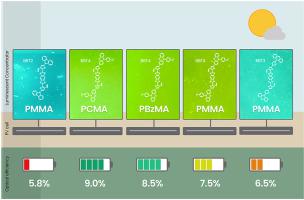Dyes and Pigments ( IF 4.1 ) Pub Date : 2021-02-02 , DOI: 10.1016/j.dyepig.2021.109207 Costanza Papucci , Alessio Dessì , Carmen Coppola , Adalgisa Sinicropi , Greta Santi , Mariangela Di Donato , Maria Taddei , Paolo Foggi , Lorenzo Zani , Gianna Reginato , Andrea Pucci , Massimo Calamante , Alessandro Mordini

|
Three new fluorophores (BBT2-4) with a D-A-D structure, characterised by the common benzo[1,2-d:4,5-d′]bisthiazole (BBT) as acceptor core (A) and different donor groups (D), were designed and synthesised for use in thin-film luminescent solar concentrators (LSC). The optical and spectroscopic properties of the new dyes were analysed both in solution (toluene) and in polymeric films, using static and time-resolved techniques. All the prepared molecules showed intense emissions between 460 and 550 nm with large Stokes shift (>50 nm), moderate-to-good fluorescence quantum yields (Φf) both in toluene solution (18–73%) and in poly(methyl methacrylate) (PMMA) films (10–52%) and good optical efficiencies (5.8–7.5%) as LSC. Transient absorption spectroscopy (TAS) studies highlighted that higher Φf were related to long excited-state lifetimes and that such properties were critically dependent on the polarity of the surrounding environment. Notably, homogeneous BBT4 dispersions into the less polar poly(benzyl methacrylate) (PBzMA) and poly(cyclohexyl methacrylate) (PCMA) polymeric matrices showed higher Φf (52.6% and 65.6%, respectively) than those gathered from PMMA films. Accordingly, BBT4/PCMA films revealed significant optical efficiency of 9.0% as LSC, which was comparable to that provided by the state-of-art fluorophore Lumogen Red 305 (10.1%).
中文翻译:

用于发光太阳能聚光器的苯并[1,2- d:4,5- d' ]双噻唑荧光团:合成,光学性质和聚合物基质对器件性能的影响
三个具有DAD结构的新型荧光团(BBT2-4),其特征是常见的苯并[1,2- d:4,5- d' ]双噻唑(BBT)作为受体核(A)和不同的供体基团(D),设计并合成用于薄膜发光太阳能集中器(LSC)。使用静态和时间分辨技术,可以在溶液(甲苯)和聚合物薄膜中分析新染料的光学和光谱性质。所有制备的分子表现出460和具有大斯托克斯位移(> 50纳米),中度至良好的荧光量子产率550纳米(Φ之间激烈排放˚F)在甲苯溶液(18-73%)和聚甲基丙烯酸甲酯(PMMA)薄膜(10-52%)中均具有良好的光学效率(LSC)(5.8-7.5%)。瞬态吸收光谱(TAS)的研究强调指出更高Φ ˚F均与长激发态寿命和这种性质是极其依赖于周围环境的极性。值得注意的是,均匀的BBT4分散成较小极性的聚(甲基丙烯酸苄酯)(PBzMA)和聚(环己基甲基丙烯酸酯)(PCMA)聚合物基质显示出更高的Φ ˚F比那些由PMMA膜聚集(分别为52.6%和65.6%)。因此,BBT4/ PCMA膜显示的LSC的光学效率高达9.0%,与现有荧光团Lumogen Red 305的光学效率(10.1%)相当。








































 京公网安备 11010802027423号
京公网安备 11010802027423号